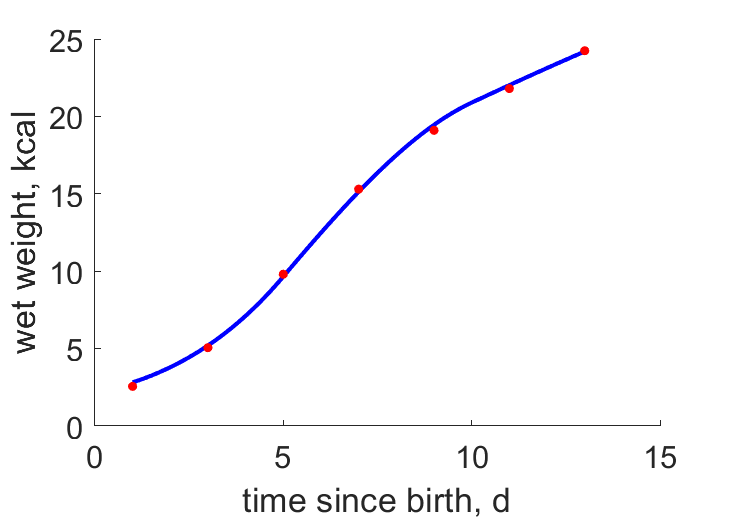Predictions & Data for this entry
| Model: std | climate: BWk, BSk, Dsa | migrate: Ml | phylum: |
| COMPLETE = 2.4 | ecozone: THp | food: biO | class: |
| MRE = 0.010 | habitat: 0iTd, 0iTa | gender: Dg | order: |
| SMSE = 0.000 | embryo: Tnpf | reprod: O | family: |
Zero-variate data
| Data | Observed | Predicted | (RE) | Unit | Description | Reference |
|---|---|---|---|---|---|---|
| ab | 14 | 14.19 | (0.01327) | d | age at birth | avibase |
| tx | 13.5 | 13.57 | (0.004888) | d | time since birth at fledging | avibase |
| tp | 40.5 | 40.38 | (0.002887) | d | time since birth at puberty | guess |
| tR | 365 | 365 | ( 0) | d | time since birth at 1st brood | avibase |
| am | 3650 | 3642 | (0.002165) | d | life span | avibase |
| Ww0 | 3.15 | 3.019 | (0.04168) | g | imitial wet weight | avibase |
| Wwi | 28.5 | 28.58 | (0.002663) | g | ultimate wet weight | avibase |
| Ri | 0.01438 | 0.01436 | (0.00153) | #/d | maximum reprod rate | avibase |
Uni- and bivariate data
| Data | Figure | Independent variable | Dependent variable | (RE) | Reference |
|---|---|---|---|---|---|
| tW |  | time since birth | wet weight | (0.01378) | Pano1996 |
Pseudo-data at Tref = 20°C
| Data | Generalised animal | Lanius phoenicuroides | Unit | Description |
|---|---|---|---|---|
| v | 0.02 | 0.03433 | cm/d | energy conductance |
| p_M | 18 | 688.6 | J/d.cm^3 | vol-spec som maint |
| k_J | 0.002 | 0.02857 | 1/d | maturity maint rate coefficient |
| k | 0.3 | 0.3033 | - | maintenance ratio |
| kap | 0.8 | 0.9598 | - | allocation fraction to soma |
| kap_G | 0.8 | 0.8011 | - | growth efficiency |
| kap_R | 0.95 | 0.95 | - | reproduction efficiency |
Discussion
- Scaled functional response varies in time
- mod_1: Pseudo-data point k is used, rather than k_J; Data set tp and parameter t_R are added, the latter replacing clutch interval t_N. Postnatal T is based on PrinPres1991, see get_T_Aves. See further the revision page, theme puberty
Bibliography